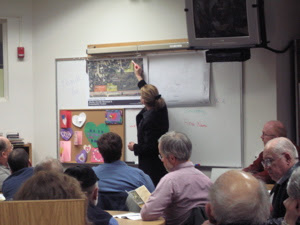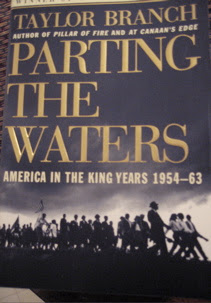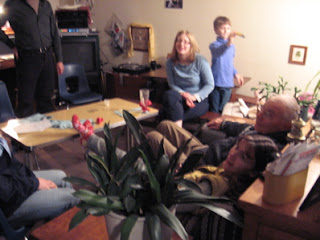 (If you click on the picture you can get a larger version.)
(If you click on the picture you can get a larger version.)Basically, the group owns a one acre parcel on 36th Avenue (the grey line on the bottom of the map). 36th is a four lane road that goes through two residential neighborhoods and carries a lot of traffic to the University of Alaska Anchorage. There are no commercial properties until you get further east or west. There's a church across the street from the property. There is a wetland area designated Jaobson park next to the site, and another park, David Green Park across 36th, which has a playground. A couple houses face 36th in the last block or so before the university. So as you drive this stretch you mostly green from fenced back yards, park, or wetlands. (Well now you see mostly white.)
The currently owned parcel is the orange rectangle at the bottom left of the map. Right now there is only a mikva on that lot, and it was built about 8 years ago. A mikva, a ceremonial bathhouse. According to www.chabad.org:
"... the most important and general usage of mikvah is for purification by the menstruant woman.
For the menstruant woman, immersion in a mikvah is part of a larger framework best known as Taharat Hamishpachah (Family Purity). As with every area of Jewish practice, Family Purity involves a set of detailed laws; namely, the "when," "what," and "how" of observance. Studying with a woman who is experienced in this field is the time-honored way of gaining familiarity and comfort with the practice. In cities or communities with large Jewish populations, there may be classes one can join. The majority of women, however, come by this knowledge through a more personal one-on-one encounter. While books are a poor substitute for a knowledgeable teacher, select titles can be used as a guide to this ritual or for quick reference (see suggested book list in appendix to this essay). What follows is only a brief overview of these laws. It is not, and was not intended to be, a substitute for proper study of this subject.
Family purity is a system predicated on the woman's monthly cycle. From the onset of menstruation and for seven days after its end, until the woman immerses in the mikvah, husband and wife may not engage in sexual relations. To avoid violation of this law, the couple should curtail their indulgence in actions they find arousing, putting a check on direct physical contact and refraining from physical manifestations of affection. The technical term for a woman in this state is Niddah (literal meaning: to be separated).
Exactly a week from when the woman has established the cessation of her flow, she visits the mikvah. Immersion takes place after nightfall of the seventh day and is preceded by a requisite cleansing. The immersion is valid only when the waters of the mikvah envelop each and every part of the body and, indeed, each hair. To this end, the woman bathes, shampoos, combs her hair, and removes from her body anything that might impede her total immersion."
It was also interesting to read on that website that:
"Today it is not just a Jewish metropolis that can boast a mikvah. In remote, even exotic, locations- Anchorage, Alaska, and Bogota, Colombia; Yerres, France, and Ladispoli, Italy; Agadir, Morocco, and Asuncion in Paraguay; Lima, Peru, and Cape Town, South Africa; Bangkok, Thailand, and Zarzis, Tunisia; and almost every city in the C.I.S. (former Soviet Union) -- there are kosher and comfortable mikvahs and rabbis and rebbetzins willing and able to assist any woman in their use."
 At the meeting there was some disagreement about what was said when the mikvah was built. One man said that it was only going to be a mikva, and no they were not planning to build anything else. Rabbi Greenberg, standing in this picture, said they had always planned to build a synagogue there, but at the time they didn't have enough money to do that as well. But now they have decided to also have a Jewish Museum attached as well. They have enough room for the synagogue and the museum on the one acre. According to John Nabors, the project manager, the buildings can take up to 30% of the property and thus the synagogue and attached museum meet that requirement. The problem comes in because "the city requires parking..." for about 70 cars. So they would like the parcel in yellow next to the orange box for parking. That is part of the designated Class A wetlands (Otis Lake drains into this area) owned by the city. Lot 14 - the backwards L shaped Yellow in the upper right quadrant of the map - is owned by people involved with the synagogue and they want to swap that land for the parcel next to the proposed building.
At the meeting there was some disagreement about what was said when the mikvah was built. One man said that it was only going to be a mikva, and no they were not planning to build anything else. Rabbi Greenberg, standing in this picture, said they had always planned to build a synagogue there, but at the time they didn't have enough money to do that as well. But now they have decided to also have a Jewish Museum attached as well. They have enough room for the synagogue and the museum on the one acre. According to John Nabors, the project manager, the buildings can take up to 30% of the property and thus the synagogue and attached museum meet that requirement. The problem comes in because "the city requires parking..." for about 70 cars. So they would like the parcel in yellow next to the orange box for parking. That is part of the designated Class A wetlands (Otis Lake drains into this area) owned by the city. Lot 14 - the backwards L shaped Yellow in the upper right quadrant of the map - is owned by people involved with the synagogue and they want to swap that land for the parcel next to the proposed building. T
 There was a lot of discussion about drainage. An engineer, an architect, and a landscape architect all spoke. A woman from the Anchorage Waterways Council was also there and answered questions, such as, "It appears to me that the parcel they want to trade which is practically unbuildable because of the water is much less valuable than the parcel with frontage on 36." She said, (I'm paraphrasing) "You are absolutely right from a real estate perspective. The land on 36th is much more valuable. But from an ecologically standpoint, Lot 14 is far more valuable. The 36th lot has been filled in by the City when they widened 36th to four lanes. The City essentially destroyed that part of the wetland."
There was a lot of discussion about drainage. An engineer, an architect, and a landscape architect all spoke. A woman from the Anchorage Waterways Council was also there and answered questions, such as, "It appears to me that the parcel they want to trade which is practically unbuildable because of the water is much less valuable than the parcel with frontage on 36." She said, (I'm paraphrasing) "You are absolutely right from a real estate perspective. The land on 36th is much more valuable. But from an ecologically standpoint, Lot 14 is far more valuable. The 36th lot has been filled in by the City when they widened 36th to four lanes. The City essentially destroyed that part of the wetland." There was discussion about neighborhood basements being flooded. There were promises made that the footpaths from the neighborhoods through the wetland to 36th would be preserved for the public use. And that the parking lot would be open to the public to visit Jacobson Park and that the synagogue group would donate $100,000 to make improved access to the park. And all of this is in writing in the brochures announcing the meeting.
So, this was a meeting put on by the people who want to build. It was not a community council meeting, nor a city run meeting. John Nabors said at the very beginning of the meeting that they have not applied for any permits and so the city really has no official position on this. But they have spent a lot of time talking to people at the City from the mayor to people in the various departments that will be involved in permitting.
The apparent purpose of the meeting was engage the community in dialogue and win their support prior to an Assembly meeting on Feb 13 at which time the Assembly will vote on putting the land swap on the ballot for April 3. If that is passed, then there needs to be Corps of Engineer Approval for building on the wetlands, and various other approvals. The land swap will be contingent on all the other "dominoes falling into place."
We left the meeting after about 2 hours so I'm not sure what else was discussed. Nobody, by that time, had raised the question that had been brought up during the legislative session about the $850,000 that was appropriated by the Alaska Legislature last spring for the Alaska Jewish Historical Museum and Community Center. Some people had been concerned about the state giving money for religious purposes. It was argued that the museum would cover the history of the Jewish people in Alaska, not be a center to celebrate religious practices, though most Jewish Community Centers do have various religious ceremonies and activities in them. The fact that the synagogue and the museum will essentially be one large building would seem to bring that question up again. Is someone going to audit how the money is spent to be sure that the state isn't funding the practice of a religion? If you look at the list of other projects funded by the legislature you'll see some other museums. I just took the A's a little past Alaska Jewish Museum on the list. Is the Alaska Native Heritage Center different from a synagogue? They cover the history and traditions of the various Alaska Native peoples. They even have various dancing and other traditional native spiritual activities. Is that different?
MUNICIPALITY OF ANCHORAGE - 2006 STATE LEGISLATIVE PROGRAM RESULTS
Grant RequestedProject Name Grant Approved
Other Anchorage Organizations
African American Historical Society - Resources, Equipment & Supplies $30,000
Airport Heights Community Council - Community Patrol Supplies $10,000
Alaska Air Show Association - Arctic Thunder Air Show $61,000
Alaska Aviation Heritage Museum: Building Demolition, Facility Improvements, and construction $750,000
Alaska Energy Authority - Study of Operating the Electrical Intertie Grid $800,000
Alaska Jewish Historical Museum and Community Center $850,000
Alaska Judicial Observers, Recruit/Screen/Train $30,000
Alaska Native Heritage Center Expansion $250,000
Alaska State Troopers Museum - Archive Program $200,000
Overall, the meeting was very civil. John Nabors wanted badly to have an organized, rational, linear presentation from the beginning to the end. The sort of thing that gives one a good overview of the whole project, and is often fairly boring to listen to. Various members of the audience asked questions that took things in other areas, but were more interesing to listen to. The times I've met Rabbi Greenberg, he has greatly impressed me by his wisdom, knowledge, and decency. For a Lubavitch rabbi, he has made various adaptations to accommodate for the realities of Alaska life. He has had relatively good relations with the Reform synagogue in town, and a number of Jews attend both synagogues. Some congregants drive to services, not something normally done at orthodox synagogues. He studied in Jewish Schools where they do not explore the American constitution, so I wonder about his understanding of the subtleties of the separation of church and state. Bit given his scholarly mind, I'm sure he has explored the issue.
It will be interesting to see how this evolves. Given the rampant development in Anchorage, the fact that wetlands are being filled in right and left, I suspect that this project will proceed as scheduled and that this organization will make sincere efforts to be good neighbors.









































